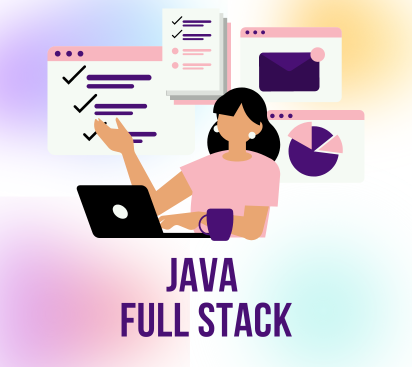

Course Content
A Java Full Stack course equips you with the skills to develop complete web applications using both front-end and back-end technologies. You'll learn Java for server-side development, including frameworks like Spring Boot, and gain expertise in front-end technologies such as HTML, CSS, and JavaScript. The course typically covers database management with SQL, and deployment techniques. By the end, you should be able to build and deploy dynamic, data-driven applications from start to finish.
Front End Syallabus
- Introduction to HTML
- History of HTML
- Components of HTML
- Structure of HTML
- Body section
- Categories of Tag in Body Section
- How to display images
- Creating List
- Ordered List
- Unordered List
- Definition List
- How to work with background?
- How to print special characters?
- Creating Tables in HTML
- Attributes of Table
- Generating Irregular Tables
- How to work with forms?
- How to work input controls?
- Using <select> Tag
- Generating Drop Down List
- Generating Scrollable List
- How to work text area?
- Introduction to HTML 5
- Improvements Given by HTML 5
- Web Forms 2.0
- New Input Elements
- New Form Attributes
- DataList Tag
- Playing Audio
- Controlling Audio
- Playing Video
- Introduction to CSS
- Advantages of CSS
- Versions of CSS
- Versions of CSS
- Types of CSS
- CSS Selectors
- Project
- Inheritance in CSS
- CSS Units
- Absolute v/s Relative Units
- Styling Background using CSS
- Handling Font in CSS
- Various Font Properties
- What are Google Fonts
- How to use Google Fonts
- Project
- Handling Text in CSS
- Various Text Properties
- Removing Underline from Links
- Handling Link in CSS
- Pseudo-Classes
- Making Links Look Like Button
- Styling Lists in CSS
- Making Nav Bar Using List
- Styling Tables in CSS
- Styling Table Border
- Creating Zebra Striped Tables
- Making Tables Responsive
- Project
- The <div> and <span> Tags
- The Difference
- Introduction to semantic HTML
- Popular Semantic HTML Tags
- The CSS Box Model
- Border, Padding and Margin
- Handling Overflow
- Setting Element Pos using Float
- The Visibility Property
- The Display Property
- Positioning in CSS
- Various Types of Positioning in CSS
- Other properties used with Positioning
- Styling form in CSS
- Attribute Selectors
- Styling Controls
- What is JavaScript?
- Who runs our JavaScript code?
- Relationship with HTML and CSS
- What JavaScript can do in Browser?
- What JavaScript can't do?
- Java v/s JavaScript
- History of JavaScript
- JavaScript Embedding
- Writing to the document
- Using Browser Console
- Comments in JavaScript
- Declaring variables in JavaScript
- Data Types
- Primitive Data Types and Non-Primitive Data Types
- Difference between null and undefined
- Var v/s let
- Types of Dialog Box
- Accepting Numeric input through Dialog box
- Using Template String
- Types of Operators
- Type Conversion & Type Coercion
- Standard rules of Number Conversion
- Controlling Decimal Points
- If
- If else
- If else if else
- Nested if
- Ternary Operator
- Switch
- While loop
- Do while loop
- For loop
- For/of loop
- For/in loop
- Array Definition
- Creating Array
- Using Loop with array
- Array with mixed type
- Creating Array using Constructor
- Array Methods
- What is Function?
- Function calling
- Calling Function from link
- Variable scope
- Returning values
- Calling function via Button
- Anonymous Functions
- Some important built-in functions
- Objects in JavaScript
- Creating Objects
- Adding properties, changing properties, and Deleting properties
- Adding methods
- Nested Objects
- Creating object using object literal
- The toString() method
- Overriding toString()
- Object equality in JavaScript
- What is JSON?
- The 'this' keyword and using of 'this' keyword
- The Arrow function
- Restriction on Arrow function
- Callback function
- Anonymous function as callbacks
- Why we need callback?
- The Date object
- The String object
- The Math object
- DOM introduction
- What is DOM?
- What can be done with DOM?
- DOM selection methods
- Setting/Getting Text Content
- Changing CSS
- Adding & Removing classes
- Traversing the DOM
- DOM properties
- DOM properties drawback
- Modern DOM properties
- Creating new element
- append() & preprend()
- Event Introduction
- Event categories
- Ways of handling events
- Using function for event handling
- Cancelling the default behaviour
- Using DOM event handler
- Working with MouseEvents
- Working with KeyBoard Events
- Determining the key Pressed
- Using DOM level 2 event handler
- The event object
- Event Bubbling
- Event delegation
- Accessing form object through JavaScript
- Accessing Form data
- The submit event & how to handle submit event
- Other form events
- Creating A ToDo List App
- Apply All The Concepts Learnt Till Now
Core Java Syallabus
- Prerequisites of Leaning of Java
- Necessity of Learning Java
- Brief History of Java
- What is Java ?
- What is Platform Independent ?
- Where Java stands today ?
- Platform Independent
- Automatic memory management
- Secure
- Robust
- Simplicity
- Multithreaded
- History of Java
- Edition of Java
- Difference between JDK , JRE and JVM
- Downloading JDK
- Installing JDK
- Verifying The installing
- Different ways of writing a Java code
- Introduction of main()
- Why main() is public ?
- Why main() is static ?
- What is String [ ] args ?
- Understanding System.out.println()
- Saving the source code
- Compilation process and it's explanation
- Executing the code
- Discussion About some important Errors
- Brief introductions of import & java.lang
- Data types
- Primitive & Non primitive data types
- Type Conversion
- Implicit Type Conversion
- Explicit Type Conversion
- Type Conversion in expression
- Introduction of operators
- Displaying values of variables
- Concatenating using '+' operator
- Concept of Default values
- Using 'Math' class
- Program to calculate circumference and Area of circle
- Various ways of accepting input
- Accepting input through Command Line Argument
- Wrapper Classes
- Uses of wrapper classes
- Converting string to primitive
- Why did Exception occur when accepting input in some cases ?
- Scanner Class
- Accepting String & Integers
- InputMismatchException
- Concepts of object & object reference
- Introduction of String in java
- Creating object of String
- Important methods of String
- Concatenating String
- Discussion of decision control statement
- If, If - else, nested if
- Switch
- Ternary operator
- Loop structure and it's types
- while and do while loop
- for loop
- Labeled break and continue
- Nested loop
- Arrays (Types & Syntax)
- How JVM handles dynamic blocks ?
- Garbage Collector
- Enhanced for loop
- Drawback of enhanced loop
- Two dimensional arrays
- Rectangular 2D array
- Jagged 2D Array
- Objects And classes
- Pillars of OOP
- Creating a class and its object
- Access modifiers
- Creating methods in class
- Initialising data members of the class
- Creating parametrised method in a class
- Initialising Object or Data members
- Explicit initialisation
- Using constructor
- Parametrised constructor
- Arguments passing
- Passing variables
- Passing array reference
- Returning array reference
- Using “this” keyword
- Using the keyword “static”
- static data members
- Garbage collector
- The 'Object' class
- Using “static” methods
- Properties of “static” methods
- Factory methods
- “static” block
- Types of Inheritance
- Using keyword “super”
- Constructor calling in inheritance
- Calling parametrised constructor in inheritance
- Calling non-parametrised constructor in inheritance
- Method Overriding
- Overloading vs Overriding
- Relationship between base class reference & derived class object
- Polymorphism dynamic method dispatch
- Binding
- Abstract classes and methods
- Using “final” keyword
- final data members
- final methods
- final classes
- Interfaces
- What's new in interface
- Interface with runtime polymorphism
- Inheriting one interface into another
- Packages
- Benefits of packages
- Creating packages inside the bin or outside the bin
- Setting path & classPath
- Access modifiers or visibility modes
- Using static import
- Solving ambiguity in packages
- What is Exception handling
- Exception handling keywords
- try and catch
- Exception hierarchy
- Obtaining description of an Exception
- Using the keyword “throw”
- Checked and Unchecked Exception
- Creating programmer defined exception / custom exception
- Using the keyword “finally”
- Multiple catch feature in java
- String handling
- Constructors & methods of String class
- StringBuffer
- Constructors & methods of StringBuffer class
- File Handling
- Operations on File
- The File class
- Constructors & methods of File class
- The FileReader class
- The BufferedReader class
- The Writer class
- What is Collection ?
- Advantages of Collections
- Array vs Collections
- Types of Collections
- Hierarchy of Collection
- Important methods of Collections
- Collection vs Collections
- The “ArrayList” Class
- Type un safe And Type safe ArrayList
- Operation of ArrayList
- Introduction & Creation of Custom ArrayList
- The “LinkedList” Class
- Internal Mechanisms of LinkedList
- Operation of LinkedList
- The “HashSet” Class
- Operation of HashSet
- What is an Iterator ?
- Methods of Iterator
- Working of an Iterator
- Why duplicates were not removed ? ( Concept of Hashcode )
- The “TreeSet” Class
- Introduction & Adding custom object to TreeSet
- Methods of TreeSet
- HashSet vs TreeSet
- Important methods of Map
- Important methods of Entry
- The “HashMap” Class
- Constructor of HashMap
- Adding & retrieving data in HashMap
- Methods of HashMap
- The “TreeMap” Class
- Adding & retrieving data in TreeMap
- Methods of TreeMap
- HashMap vs TreeMap
Advance Java Syllabus
- Course Overview
- Web Application
- Full stack development
- Course Outline
- Introduction To JDBC
- Introduction To DBMS
- History And Editions Of JDBC
- JDBC Architecture
- How JDBC Manages Connections To The Database ?
- JDBC Packages
- Steps Required In JDBC Programming
- SQL -Database language
- Query –insert , update , delete
- Executing Non Select Queries From JDBC
- Dynamic SQL
- PreparedStatement
- Creating scrollable and updateable ResultSet
- ResultSet concurrency
- Insert update delete in Resultset
- How to retrieve date from database ?
- How to store date in the database ?
- How to insert images in the database ?
- How to retrieve images from the database ?
- Executing batch updates.
- Executing batch updates using statements.
- Executing batch update for prepared statement.
- Transaction management.
- Disconnected architecture.
- Establishing connection to database with a CachedRowSet.
- Updating the CachedRowSet.
- Inserting records in CachedRowSet.
- Deleting a record.
- Servlets Introduction
- What Is The Need Of A Servlet ?
- Servlet Container
- Request and response of Servlet
- LifeCycle Of a Servlet
- Introduction To GenericServlet class
- Creating The Sevlet.
- Introduction To HttpServlet.
- Differences With GenericServlet
- Introduction To doGet( ) and doPost( )
- Writing Servlet By Extending HttpServlet
- Calling Servlet Using HTML Page
- Methods Of ServletRequest And HttpServletRequest
- Obtaining Client Info
- Reading Form Parameters
- Connecting A Servlet To The Database
- Inter Servlet Communication
- Transferring Request
- Using Request Redirection
- Using Request Dispatching
- Using forward() and include()
- Introduction To Initialization Parameters
- Using Servlet Initialization Parameters
- Using Context Initialization Parameters
- Using Context Listener
- Introduction To JSP
- Servlet v/s JSP
- Request Processing In JSP
- JSP Tags
- Types of JSP Elements
- Scriptlet Tag
- Declarative Tags
- Expression Tag
- List Of Implicit Objects In A JSP Page
- Comments
- The MVC Model
- Introduction To JSP Directives
- The @page Directive
- Attributes of @page Directive
- The @include Directive
- Introduction To Session Tracking
- Session Tracking Mechanisms
- Using Hidden Field
- Session Tracking Using Session API
- The HttpSession Interface
- Working Of HttpSession
- Methods Of HttpSession
- Session Counter
- Session Tracking Without Cookies
- Event Handling In Session Tracking
- Introduction To Query String
- Using Cookies
- Important Methods Of Cookies
- Examples
- Introduction To Java Beans
- Creating Bean Objects
- Using Bean Setter And Getter Methods
- Using Bean With HTML
- Introduction To EL
- Advantages Of EL Over Java Beans
- EL Attributes
- EL Operators
- Introduction To Custom Tags
- Advantages Of Custom Tags
- Ways To Create Custom Tags
| Full Stack Java Introduction | Preview |
| Core Java (JSE) Lecture - 1 | Preview |
| Core Java (JSE) Lecture - 2 | Preview |
| Core Java (JSE) Lecture - 3 | Preview |
| Core Java (JSE) Lecture - 4 | Preview |
| Core Java (JSE) Lecture - 5 | Preview |
From Basics to Advanced Java Full Stack Development
- Full Stack Mastery: Learn Java full stack development, covering both frontend and backend technologies from basics to advanced.
- Zero to Hero: Progress from a beginner to a proficient full stack developer using Java technologies.
- Comprehensive Coverage: Understand everything from frontend frameworks like Angular or React, to backend development with Spring Boot, and database management.
Live Lectures
- 100+ Hours: Engage in live, interactive sessions with industry experts in Java full stack development.
- Hands-on Practice: Gain practical experience by coding during live sessions and working on full stack projects.
- Practice Sessions: Participate in dedicated practice sessions to refine your skills in both frontend and backend technologies.
Doubt Solving
- Unlimited Doubt Clearing Sessions: Get all your questions answered with support from experienced instructors.
Test Series and Assignments
- Topic-Wise Test Series: Evaluate your understanding with tests after each major topic, covering both frontend and backend.
- Assignments: Apply your learning through practical assignments, including building full stack applications.
Lecture Notes
- Detailed Notes: Access comprehensive notes for every lecture, covering all aspects of Java full stack development.
Projects
- Real-World Projects: Work on live projects to build and deploy full stack applications using Java technologies.
- Integration Techniques: Learn to integrate frontend frameworks with backend services and databases.
- Best Practices: Understand and implement best practices for developing scalable and maintainable full stack applications.
Certifications
- Dual Certification: Receive two certificates upon successful course and project completion.
- Java Full Stack Development Completion Certificate: Earn a certificate for mastering full stack development with Java technologies.
- Project Completion Certificate: Get certified for successfully completing your full stack development project.
Laptop / Computer Spefiications
- System With Minimum I3 Processor Or Better
- At Least 4 Gb Of Ram
Java Development Kit (JDK)
Integrated Development Environment (IDE)
Build Tools
Version Control
Database
Application Servers (Optional)
Documentation
Additional Libraries
Ready to kick-start your career?
Join Us Now Join Us Now



